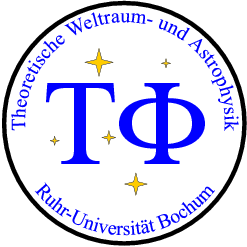Winds around runaway stars, or in general, stars with a nonzero relative speed with respect to the surrounding interstellar medium (ISM), develop bullet-shaped astrospheres.
The hydrodynamic large-scale structure is sketched in Fig.~1 and in more detail in Figre~2 the notation of which is described below.


The hypersonic stellar wind (Mach numbers \(Ma \gg 1\)) undergoes a shock transition to subsonic velocities at the termination shock (TS) in the inflow direction. Then a tangential discontinuity, the astropause (AP), is formed between the ISM and the stellar wind, where the velocity normal to it vanishes: there is no mass transport through the AP. Other quantities such as the tangential velocity, temperature, and density are discontinuous, while the thermal pressure is the same on both sides. If the relative speed, or the interstellar wind speed as seen upwind in the rest frame of the star, is supersonic in the ISM, a bow shock (BS) exists. If the relative speed is subsonic, there will be no BS. The region between the BS and AP is called outer astrosheath, the region between the AP and TS the inner astrosheath. The AP around the inflow direction at the stagnation line is sometimes called the nose, while the region beyond the downwind TS is called the astrotail. The latter can extend deep into the ISM. The region inside the TS is called the inner astrosphere.
In the downwind direction, the termination shock forms a triple point, from which the Mach disk (MD) extends down to the stagnation line; this is the line through the stagnation point and the star. A tangential discontinuity (TD) emerges down into the tail. A reflected shock (not shown here) also extends from the triple point toward the TD.
This is the standard shape of an astrosphere using a single hydrodynamic fluid \citep{Baranov-etal-1971,Pauls-etal-1995}. For the large dimensions of O-star astrospheres, cooling operates inside the outer astrosheath, but usually not in the inner astrosheath. Cooling is also present beyond the model boundary (see Table~ ef{tab:2}) of the inner astrosphere, which leads to relative sizes of these regions different from that of pure hydrodynamic flow.
The astrosphere is always bullet-shaped, which can be seen by the conservation of momentum: \(\rho_{sw} v_{sw}^{2} + P_{sw} = \rho_{ISM}v_{ISM}^{2} + P_{ISM}\), where \(\rho, v, P\) are the density, velocity, and the thermal pressure of the stellar wind (subscript \(_{sw}\)) and the ISM (subscript \(_{ISM}\)). The stellar wind pressure is usually neglible inside the TS. For hypersonic flows this holds true for the thermal ISM pressure in inflow direction, while for subsonic inflows the thermal pressure dominates. In the tail direction, only the thermal ISM presssure is present beyond the TS. This means that even if the inflow is subsonic, there is a total pressure asymmetry between upwind and downwind as long as the ISM velocity does not vanish. Thus on long time and large spatial scales, a bullet-shaped astrosphere will develop.
(taken from Scherer et al 2015a and Scherer et al 2015b

